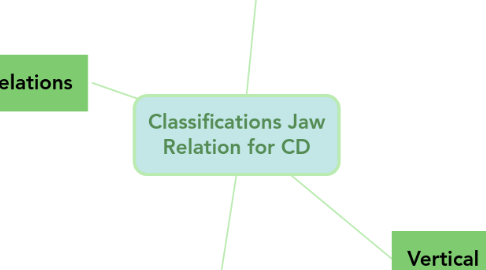
1. Orientation relation
1.1. orient the mandible to the cranium
1.2. position of the condyle to the hinge axis of the cranium
1.3. By using facebow
1.3.1. caliper like devise that is used to record the relationship of the jaw to the TMJ
1.4. Arbitrary
1.4.1. bite fork is placed in maxillary rim
1.5. Kinematic
1.5.1. bite fork is placed mandibular rim
1.5.2. bite fork is placed mandibular rim
2. Vertical Relations
2.1. distance between selected points
2.2. only two arbitrary selected points
2.2.1. one above
2.2.2. one below the mouth
2.3. METHODS OF DETERMINING THE VERTICAL DIMENSION
2.3.1. PHYSIOLOGIC
2.3.1.1. Physiologic position
2.3.1.1.1. postural position that is controlled by the muscles that open , close, retrude and protrude the mandible.
2.3.1.1.2. Factors affecting are
2.3.1.1.3. Let the patient sit in erect position head unsupported by head rest and the ala- tragal line is parallel with floor. Ask the pt to wet the lips and say “EMMA”
2.3.1.2. Esthetics
2.3.1.2.1. Evaluates the normal relaxed position , lips are even and in slight contact.
2.3.1.2.2. Increase VD
2.3.1.2.3. Decrease VD
2.3.1.2.4. Swallowing Threshold
2.3.1.3. Phonetics
2.3.1.3.1. Labial “m” sound
2.3.1.3.2. The “S” sound
2.3.1.3.3. The “th” sounds
2.3.1.3.4. The “f and v” sound
2.3.1.4. Swallowing
2.3.1.4.1. If denture occlusion is missing
2.3.1.4.2. If there is difficulty
2.3.1.5. Tactile sense
2.3.1.5.1. Patient tactile sense
2.3.1.5.2. Boos bimeter
2.3.1.5.3. Electromyography
2.3.2. MECHANICAL
2.3.2.1. Ridge relation
2.3.2.1.1. Distance of the incisive papilla from the mandibular incisors
2.3.2.1.2. Parallelism of the ridges
2.3.2.2. measurement old denture
2.3.2.2.1. Made between the borders at maxillary and mandibular denture
2.3.2.3. Pre-extraction record
2.3.2.3.1. Profile radiograph
2.3.2.3.2. Profile Photograph
2.3.2.3.3. Cast of teeth in occlusion
2.3.2.3.4. Facial measurements
2.4. Types
2.4.1. Vertical Dimension at Occlusion (VDO)
2.4.1.1. when the teeth or occlusion rims are in contact in centric occlusion
2.4.1.2. VDO=VDR-FWS
2.4.1.3. Tests establishing the correct VDO
2.4.1.3.1. Visual observation of the space
2.4.1.3.2. Judgment of the overall esthetic facial support.
2.4.1.3.3. Phonetic tests that include observations when the “s”sound
2.4.1.4. Consequences on Increased Vertical Dimension
2.4.1.4.1. m a on the on the tissue Due to premature striking of teeth
2.4.1.4.2. pain in TMJ
2.4.1.4.3. Clicking of dentures
2.4.1.4.4. easily to displaced
2.4.1.4.5. Face appears long
2.4.1.5. Consequences of Decreased Vertical Dimension
2.4.1.5.1. Reduces function of the muscles
2.4.1.5.2. creases at the corners of the mouth
2.4.1.5.3. loss of space in oral cavity
2.4.1.5.4. Chin appears to far forward
2.4.1.5.5. Shrunk appearance of the face
2.4.1.5.6. Ve r m i l l i o n borders of the lips reduce
2.4.1.5.7. Lips lose their fullness
2.4.1.5.8. Face is flabby instead of being firm
2.4.2. Vertical Dimension at Rest (VDR)
2.4.2.1. jaws in the rest position
2.4.2.2. Physiologic Rest Position of the Mandible
2.4.2.3. habitual postural position
2.4.2.3.1. patient is sitting comfortably in the upright position and the condyles are in neutral unstrained position in the glenoid fossae.”
2.4.2.3.2. Factors that influence
2.4.2.3.3. HOW to achieve it??
2.4.2.4. Established by muscle and the gravity
2.4.2.4.1. the state of minimal tonic contracture sufficient enough to maintain posture.
2.4.2.5. Measured when the head is upright in position and not supported by the headrest
2.4.2.5.1. 2-4 mm average Freeway space
2.4.3. Interocclussal Dimension IOD /Freeway space
2.4.3.1. distance between the occluding surfaces of the maxillary and mandibular teeth when the mandible is in its physiologic rest position.”
2.4.3.1.1. Difference between the vertical dimension of rest and occlusal vertical relation for comfort of patient and health of tissues and proper functioning of denture
2.4.3.2. VDR – VDO = IOD ; 2–4 mm
2.4.3.2.1. Skeletall ClassI – 2-4mm; Class II and III - >4mm
2.4.3.3. Importance
2.4.3.3.1. Allows relaxation of the masticatory apparatus
2.4.3.3.2. Excessive loading of the denture bearing tissues - If eliminated
3. Horizontal Relations
3.1. characterized by the front to back and side to side relationship of the mandible with the maxilla.”
3.2. Centric relation
3.2.1. basic horizontal jaw relationship
3.2.2. most retruded physiologic relation of the mandible to the maxilla to and from which the individual can make lateral movements.
3.2.3. independent of tooth
3.2.3.1. guided, repeatable, learned and recordable position
3.2.3.2. Bone to bone relationship
3.2.4. Occurs around terminal hinge axis
3.2.5. Point of reference of establishing CO
3.2.6. Not a postural position
3.2.6.1. constant for any person
3.2.7. Condyles articulate with thinnest, avascular portion disks
3.2.7.1. Anterior-superior position against slope of the articular eminence
3.2.8. Indications
3.2.8.1. When entire occlusion being restored
3.2.8.2. No remaining posterior centric stops
3.2.8.3. When complete, fixed, or removable partial dentures involve the entire occlusion
3.2.9. METHODS OF RECORDING CENTRIC RELATION
3.2.9.1. Interocclussal Check Record
3.2.9.1.1. Tactile Method
3.2.9.1.2. Physiologic method
3.2.9.1.3. Most common, less time and less equipment
3.2.9.1.4. Uses waxes , dental plaster, ZOE paste
3.2.9.2. Graphic methods
3.2.9.2.1. Uses graphic tracing (GOTHIC ARCH TRACER) to record the mandibular movements.
3.2.9.2.2. The apex of graphic tracing indicates the position of CR.
3.2.9.2.3. Most accurate making CR with mechanical instruments.
3.2.9.3. Functional method
3.2.9.3.1. Needles-House technique and Patterson technique
3.2.9.3.2. Uses tentative wax record at the tentative VDO
3.2.9.4. METHODS OF RETRUDING Mandible
3.2.9.4.1. Passive
3.2.9.4.2. Active
3.2.9.4.3. TECHNIQUE
3.3. Centric Occlusion
3.3.1. maximum intercuspation when the mandible is in most retruded position in relation to maxilla; tooth determined relation”
3.3.2. occlusion of opposing teeth when the mandible in CR.
3.3.3. Habitual and unguided determines the CO
3.3.4. Tooth contact determined position
3.3.5. In Complete Denture
3.3.5.1. Centric Relation =Centric Occlusion=Maximum Intercuspation
3.3.6. In Natural dentition
3.3.6.1. CR n CO do not coincid
3.4. Eccentric relation
3.4.1. Protrusion
3.4.2. Lateral excursion
3.4.3. Right lateral occlusion
3.4.4. Left lateral occlusion
3.4.5. Protrusive occlusion
